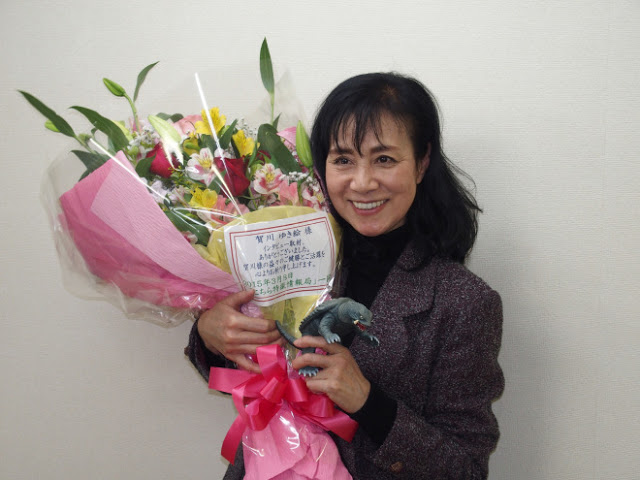
Actress Yukie Kagawa holds a bouquet of flowers and a Bandai Gamera figure following an interview on her acting career. Photo © Brett Homenick.
Yukie Kagawa is an actress whose career has touched most of the major studios in Japan. Working in genre movies and TV programs at Daiei, Shochiku, and Toei, Ms. Kagawa has played a wide variety of roles, from leading ladies to treacherous villains. With a career that has covered everything from the Gamera series to Super Sentai, Ms. Kagawa has made an indelible impact on the Japanese special-effects genre, but it is one that has not been discussed at length until now.
Vantage Point Interviews would like to thank Mr. Tsuyoshi Tanaka for all his help in arranging this interview as well as Ms. Ayu Ogawa for her tireless translations. This interview could not have been conducted without their faithful support.
Brett Homenick: First, please tell me about your early life, growing up. Tell me about your childhood.
Yukie Kagawa: I was very interested in theater and acting. I joined an acting company when I was in elementary school.
BH: So tell me about some of the things you did in elementary school with your acting. What kinds of plays did you do?
YK: I was in that company, but I didn’t do professional work. I did King Lear. When I was in junior high school, I started some acting jobs at Daiei. Then I enrolled in Daiei Company. But I started as an extra.
BH: Tell me about how you got started at Daiei as an extra. How did that happen?
YK: When I was in that company, I may have been scouted as an extra. That’s why I started acting as an extra and then later became a professional.
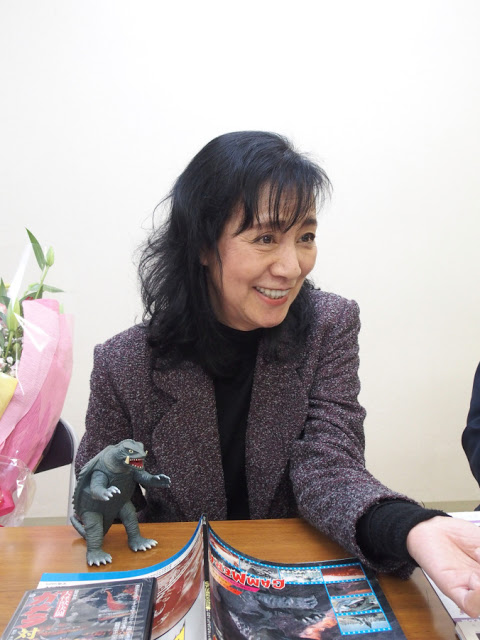
Photo © Brett Homenick.
BH: When you started with the extra work at Daiei, what was it like to work in the background of those movies at that time? It was your first time, so what were your thoughts and impressions at the beginning of being an extra at Daiei?
YK: I was so impressed to see such famous people around. At that time, I was very tall, so everybody noticed me. That’s why I was picked. (laughs) I was so tall for my age.
BH: How did it come about that you got hired by Daiei as more than just an extra? Were you under contract at Daiei when you were hired?
YK: I got a test to get into Daiei Company, and I had half-year lessons like flower arrangement, Japanese tea ceremony, theatrical combat, and horse riding. Raizo Ichikawa was one of the teachers.
BH: What are your memories of Mr. Ichikawa?
YK: There were people who went to Mr. Ichikawa and those who went to Mr. Shintaro Katsu. I was one of those who went to Mr. Ichikawa. So I was in his movies, but he went to Tokyo Daiei Company. (He went back to Tokyo Daiei Studios to make Nakano Army School: Top Secret Command (1967). After that, he came back to Kyoto.) That’s my memory.
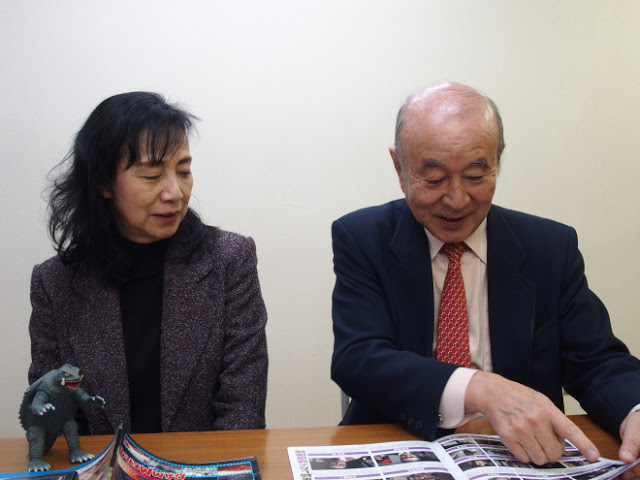
Yukie Kagawa and her manager (retired actor Sadafumi Kawahara) reflect on acting in Daiei’s Gamera series. Photo © Brett Homenick.
BH: When you were hired by Daiei, were you in Kyoto’s Daiei (studio)?
YK: I spent a year in Kyoto, then moved to Tokyo. The chief of Daiei told me, “You are too tall, so go to Tokyo!” because I was too tall. (laughs)
BH: So the training at Kyoto Daiei was about a year?
YK: Two years in Kyoto. Half a year training in Kyoto, spending a whole two years in Kyoto in total.
BH: Your first movie with your first major role was, perhaps, as the young girl in Gamera vs. Barugon. So what can you tell us about working on Gamera vs. Barugon (1966)?
YK: That movie was directed by Mr. (Shigeo) Tanaka, and my role had no lines at all as a deaf-mute. So it was very hard.
My real name is Hiroko Nishi. Do you know Mr. Yusuke Kawazu? He named me ”Yukie Kagawa.” He was in the movie Ken (1965), and the name of his character was Mr. Kagawa. So I was named after his character. “Yuki” means snow, but if you write it in Chinese characters, it goes out so suddenly. That’s why I put it in Japanese characters instead of Chinese characters. “E” means a picture, and it means to be as beautiful as a picture book. So I’ve grown up so beautifully. (laughs) That’s what it means.
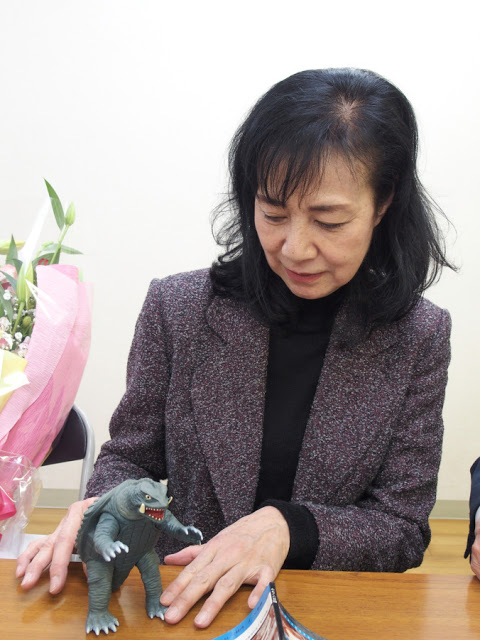
Photo © Brett Homenick.
BH: In the movie Gamera vs. Barugon, you’re onscreen Kojiro Hongo and (Kyoko) Enami. What do you remember about working with these two Daiei stars?
YK: Ms. Enami was a very good friend. She and I were in Kogarashi Monjiro (a.k.a. Withered Tree, the Adventures of Monjiro, 1972) together, which is a Toei movie. That was my first movie as a Toei actress. Mr. Hongo was a good friend of mine as well. He was in the TV series Tokusou Saizensen (a.k.a. Special Investigation Frontline, 1977-87). Whenever he saw me, he’d say, “Hi, how are you doing?”
BH: Where were your scenes filmed for Gamera vs. Barugon?
YK: It was on a set. There was no location. I thought it was very beautiful. It was an open set.
BH: Were you in Gamera vs. Gyaos (1967)?
YK: Yes, I was. My friend, Reiko Kasahara, was in the movie with a good role, so she and I were very pleased that she was in the movie because I liked her and cared about her very much.
BH: After Daiei, you made a movie at Shochiku called Cruel Ghost Legend (1968). How did you get to Shochiku? What do you remember about making this controversial film?
YK: Mr. Kawazu was in the union called Theatre de Poche (a union in Japan for actors). (Tomokazu Miura belongs to this union now. Tetsuro Tamba was a well known actor in the union at that time.) I was in this union. Because Mr. Kawazu was in the union as well, he invited me to the union and that made me act in the movie.

Photo © Brett Homenick.
BH: What did you think of this movie?
YK: I was very shocked. I regretted it. (laughs) I did all kinds of roles, and I was so excited about that. I was so happy to have all kinds of roles as an actress.
BH: After that film, you switched to Toei. Please talk about the transition to Toei Studios.
YK: The union itself had the connection with Toei. That’s why I could not appear in the movies of other studios.
BH: Was this your first studio contract with Toei?
YK: I had to be only in Toei movies. (The contract was with the union because of Gosha Kyotei, the Five-Company Agreement.)
BH: When you joined Toei, you were in The Snake Woman’s Curse (1968).
YK: (laughs) Yukiko Kuwahara has the main role. Everybody thinks I have the main role. Preparing the costumes and makeup took a long time.
(For the makeup,) I had to stand still. It took a whole three hours. I had to put every piece of makeup on. I put on the pants first and then put on the pieces, one by one. I had to put the pieces on my face as well. So that’s why it took such a long time. That made me sick! (laughs)

Photo © Brett Homenick.
BH: On this film, you worked with director Nobuo Nakagawa. So please tell me about working with Mr. Nakagawa.
YK: He was a very, very nice person. He wore geta all the time and wore a tenugui (handkerchief) in his back pockets. He was very friendly. He didn’t look like a director. He looked like an ordinary person. I am in almost all the movies he directed.
BH: How would he direct you in a scene?
YK: He didn’t say anything particularly precise, so I could do as I liked. He was a wonderful director.
BH: Next we move on to another director, Teruo Ishii, for Horrors of the Malformed Men (1969).
YK: I am in all the movies directed by Mr. Ishii. He was so friendly and such a nice person. Ken Takakura was picked by Mr. Ishii for the Abashiri Prison series and got famous. So I was very honored to be in his films. He was very kind to everybody.
BH: How was his directing style? Did he also let the actors do what they wanted?
YK: He didn’t say anything to me. I could do as I liked. But, for the actors who could not do well, he spoke a lot. He wasn’t angry at all. He just wanted to help the actors. He was a very kind person.
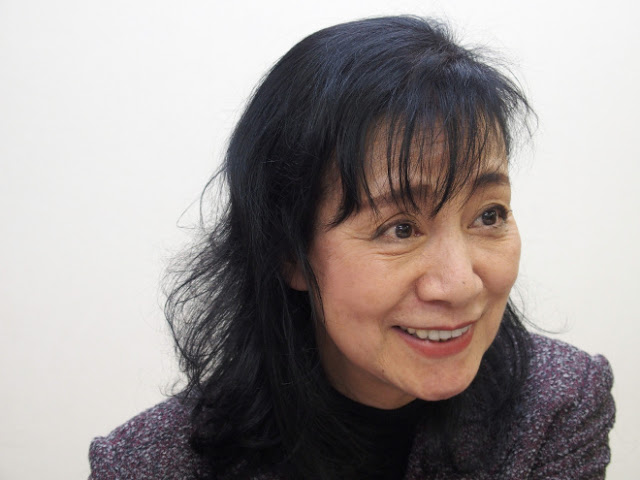
Photo © Brett Homenick.
BH: About the film, Horrors of the Malformed Men, what can you tell us about making this film?
YK: There was a group (called ankoku butou, which specialized in unusual dance theater) led by Mr. (Tatsumi) Hijikata. That whole group was really sort of weird! They were not friendly. But that made the film itself so nice and realistic. Also, many famous and talented stars, such as Asao Koike and Teruo Yoshida, were in this movie. I was so excited about that.
BH: What do you think about the contents of the story? Of course, it’s not shown in Japan.
YK: I don’t agree with the subject matter itself. I think it’s untouchable.
BH: Were there any concerns (about the story) when the movie was being made?
YK: I wasn’t worried at all at that time. I enjoyed making the film.
BH: Next is a very popular film, Female Convict Scorpion: Jailhouse 41 (1972). What do you remember about making this film and working with Meiko Kaji?
YK: Ms. Kaji’s name was Masako Ota in Nikkatsu. She changed her name at Toei. I wanted to act with her in a movie. Then my dream came true. I loved her in the movies. We both used the same brand of tobacco called “red long dark.” They were long cigarettes. We didn’t like the shorter ones. We smoked the cigarettes together.
On the set, it was a mountain scene, and I had to run in this set. Also, in this situation, it was raining. If the scene is NG (no good), I would have to dry my clothes and start over again. It was so hard. I had to carry another person (Eiko Yanami) on my back at the same time. The director made me perform this scene so many times. It was such a tough scene.
BH: Were there NG cuts?
YK: Yes, there were. NG wasn’t just about the acting; it was also about the amount of rain. This was all filmed on set, so the rain was not real.

Photo © Brett Homenick.
BH: The director was Shunya Ito. What was he like as a director?
YK: I knew him beforehand. So I could do as I wanted. He didn’t say anything to other actors, either.
BH: You also worked with Ms. Kaji and Shinichi Chiba on Wandering Ginza Butterfly II: She-Cat Gambler (1972).
YK: I’m in all the movies directed by Mr. (Kazuhiko) Yamaguchi. So I know him very well. Mr. Chiba is a very kind person. I know him very well from Key Hunter (1968-72). (But) I first met him at the studio before that. So we knew each other.
BH: During this time, what was it like to work at Toei?
YK: I’m very thankful to Toei because my name got very famous. But I think Toei must be very thankful to me because the studio made money with me.
BH: Also at Toei, you worked on the Battles Without Honor and Humanity series, with Kinji Fukasaku, a very famous director. So please talk about working with Mr. Fukasaku as director on these films.
YK: He was a very nice person. I met him on Key Hunter for the first time. I could act freely as I liked, but with other actors and actresses who could not do well, he told them, “Do this” and “Do that.” The cameraman has to follow actors all the time.(That was his shooting method.) He was different from other directors. He pointed out every word and every action.
BH: Was he the most perfectionist director that you worked with, the one who was most direct?
YK: He was good to me. Mr. Ishii was the hardest. That’s what I think. He made me do such impossible roles. That’s why I think he was the hardest. At first, I got offered to play (the bizarre killer) Sada Abe, but I said I couldn’t do it. I thought it was too hard at the time.
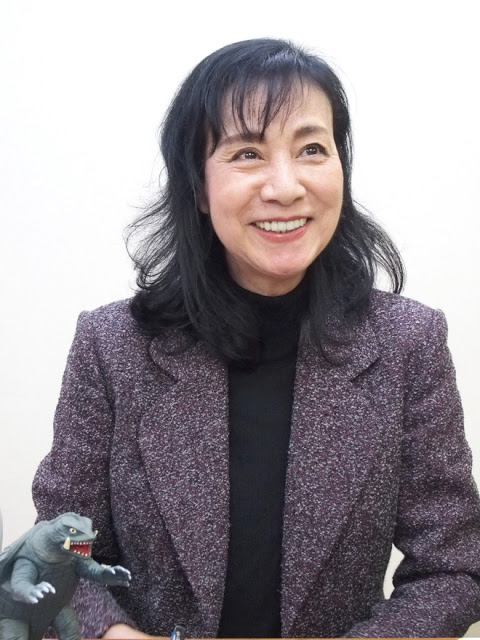
Ms. Yukie Kagawa reminisces about her career while her old friend Gamera looks on. Photo © Brett Homenick.
BH: You did Spider-Man (1978-79), the (Toei) TV show. So please talk about getting cast on the series. How was it different from doing movies?
YK: I preferred movies instead of TV because it was really hard. The hardest thing for me was having to wait such a long time to get things prepared, such as getting the sets organized.
BH: What was it like to adjust to playing a regular character who was a super-villain?
YK: Once I got into the costume, I became that character instantly. I myself cannot understand how it works, but once I got into the costume, I became that person.
BH: On (Taiyo Sentai) Sun Vulcan (1981-82), (you wear) a very interesting costume. Was it difficult to work with the costume at all, or was it rather easy?
YK: During an explosion, I actually got burned, and there were holes everywhere in my costume. So it was hot and very uncomfortable. Even so, I still had to act.
BH: With these action series, what do you remember about doing some of the fights and the choreography?
YK: The explosions were the hardest things.
BH: Which do you prefer, Spider-Man or Sun Vulcan?
YK: (pause) I prefer Spider-Man because that was the first time.
BH: What do you remember in general about working on Spider-Man?
YK: Even though my character was the enemy of the cast, they were very, very friendly in real life. They were all good friends.
BH: What do you remember about working on Sun Vulcan?
YK: They were all good friends as well. We would go out to have drinks after shooting.
BH: What are some of the things you’re doing now? Tell me about the projects and the things that you’re doing now.
YK: Since I broke some bones, I haven’t done any acting jobs. I lost my dog, and then I broke some bones. So I haven’t done any acting work for about five years. I fell down the stairs (which broke my bones), but I don’t remember when – maybe five years ago. I got offered so many jobs, but I had to take a rest.
But now I’m prepared to return to acting, including the theater and commercials.
Many thanks to Mr. Tsuyoshi Tanaka and Ms. Ayu Ogawa. The author also wishes to acknowledge the following Web sites:
http://ok-enter.com/
http://baronbaron.hungry.jp/
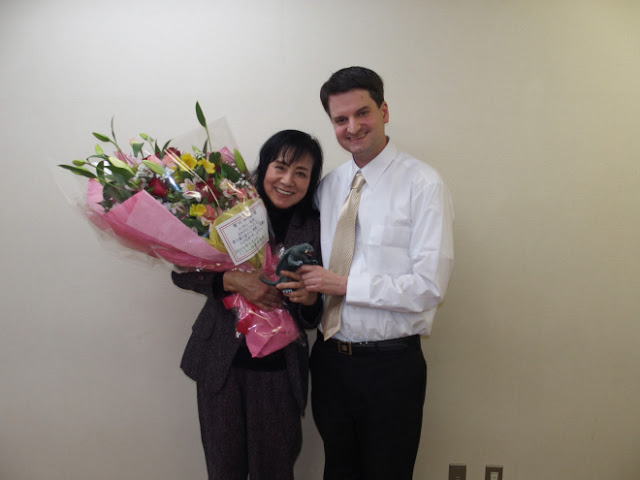
Yukie Kagawa poses with Brett Homenick following a successful interview. Photo © Brett Homenick.
I am profoundly interested in all things Japanese, from its language to its history and culture, to its pop culture, and everything in-between. Needless to say, Japanese cinema is high on my list and I have seen on the order of 1200 Japanese-language titles over the course of the past 11 years.
So, finding your interview with Yukie Kagawa was an exceedingly welcome find, and the Vantage Point Interviews with (from my perspective) other Japanese performers/talents/celebrities is an equally welcome find.
I have not been to film school, and my opinions are from my own viewpoint as a non-expert.
I’m sure I would have seen Yukie Kagawa in her role in one of the Gamera films, but it wasn’t until her roles in “Delinquent Girl Boss: Worthless to Confess” and “Wandering Ginza Butterfly 2: She-Cat Gambler” that I really took notice of her and her great acting ability–in my opinion, she was the best actress, or one of the best actress in Delinquent Girl Boss: Worthless to Confess. And by that, I mean her talent in terms of actual acting ability, as distinguished from stage presence, etc.
As always, I find a “back story” behind any Japanese film to be deeply interesting.
So thank you and Yukie and Mr. Sadafumi Kawahara, Vantage Point and all others who bring such a truly valuable resource to the Web and hence to posterity. Thankfully, you have preserved an important part of history, even if not a major world event, for history.
LikeLiked by 1 person
How can I get a Yukie Kagawa as Amazoness personally inscribed and signed photo? God bless & thank you.
LikeLike